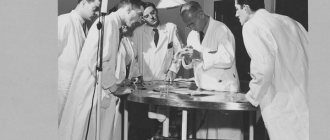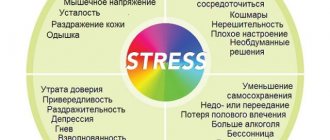Features of the physiological type of stress
The rhythm of life of a modern person accelerates every year. Today, a woman is not only a mother and homemaker, but also a businesswoman, athlete, Komsomol member and simply a beauty.
Men are also not limited to mammoth prey - they are obliged to help around the house, raise children, engage in sports, their development, business, and so on. With increasing responsibilities, many began to experience obsessive stress.
And therefore, today stress is not the privilege of suspicious young ladies, but a serious psychological and physiological diagnosis.
Stress haunts almost every modern person
What is physiological stress
Physiological stress is the human body’s reaction to any negative external stimuli (stressors). The function of stress is the mobilization experienced by the body experiencing stress.
And in small quantities, this state is really useful - a person begins to think and act more actively. However, if more stressful situations arise, then the body’s forces devoted to solving problems are simply depleted.
Moreover, this applies to both psychological resources and physiological ones.
Scientists around the world have long recognized the power of stress on the body. Many studies have been conducted, a huge number of articles and books have been written on psychophysiology, and all of them are devoted to one phenomenon - the physiology of stress.
It would seem that this process has been studied far and wide. But the psychophysiological mechanisms of its occurrence, stages of development and consequences of the influence of stressors on the psyche and health of a person are so complex that they are unique for almost everyone.
Although there are common symptoms.
The structure of the development of physiological stress
Any stressful condition, when it occurs, goes through three stages: anxiety, adaptation, exhaustion. These processes are physiological mechanisms of stress.
The first reaction that accompanies the physiology of stress is a state of anxiety. Here, the autonomic nervous system is directly involved in the process, which a person is not able to control on his own. It immediately reacts to all changes in the environment, and the degree of change in its work depends on the strength of the resulting reaction.
It is thanks to the influence of the autonomic nervous system that our body is able to adapt to external factors. So, in the dark the pupils dilate, and in bright light the pupils constrict, the hand withdraws from the hot surface, and so on. Next, the endocrine system “turns on” in the process; it is this system that allows the production of the hormone adrenaline.
This hormone “saves” the changes that have occurred.
The next stage is longer. This reaction already occurs with the participation of the brain, the amount of glucose in the blood increases, energy production increases, and much more.
There are two possible options for completing this stage - either the body adapts to new realities, or the resources will come to an end, and the third stage will begin - the period of exhaustion.
This phase of stress development is what causes all the unpleasant changes. Strength is running low, resistance is reduced, and the physical consequences of stress arise.
If the irritant is not eliminated at this stage, death is possible.
Stress-related reactions occur in the human brain
Causes of stress
The cause of stress (stressor) can be anything, any psychological or other changes. They are based on completely different features, components and reactions. Some people have difficulty going through problems in their personal lives, while others are killed by the loss of something they need.
Stressors are divided into external and internal. External ones include the death of a loved one, loss of a job, etc. Internal ones include low self-esteem, deep and constant soul-searching, and the discrepancy between ideals and reality.
If these reasons occur relatively rarely, then most people experience them easily. Stress activates hidden forces, so a person is able to cope even with very serious difficulties. The main and common cause of the negative consequences of stress is the constant occurrence of irritants.
Types of stress
Thanks to numerous research in the field of psychophysiology, two types of stressful conditions are distinguished - eustress and distress.
Eustress is positive. It triggers the changes in the body necessary to eliminate the stimulus, increases mental and physical activity, and speeds up the reaction. When you need to run a marathon, you get a “second wind”.
Or when preparing a report, an employee is able to work longer hours and much more efficiently.
It should be remembered that the resources spent on such a “marathon” must be restored, otherwise there is a high risk of the second type of stress.
Distress is negative. It appears when the body is no longer able to fight external stimuli (chronic lack of sleep or endless problems in the family, as if rotating on its own axis, conflicts at work).
This is exactly the state we mean when we say we are “under stress.” It is because of this that many people take antidepressants, alcohol, or seek help from specialists. Usually, when talking about the occurrence of stress or depression, this is what they mean.
Symptoms
To avoid the negative effects of stress on your body, both psychologically and physically, you should be attentive to yourself and your loved ones. The first symptoms of an inability to cope with difficulties on your own include:
- constant fatigue, irritability even for minor reasons;
- inability to respond adequately to people and events;
- poor sleep;
- insensitivity to positive events in life, lack of keen interest in what is happening;
- the inability to “forget” about your problems for a while and relax;
- low activity.
If someone begins to notice similar manifestations of stress in themselves or their loved ones, they should be wary and be sure to understand the reasons, and then eliminate them as much as possible and restore strength. The consequences of undetected signs of stress in time can be serious, because irreversible processes occur in the body.
If a sharply negative attitude arises towards one’s own work or boss, many take it for granted; there is no escape from it, because having an income is vital. Irritation and fatigue gradually accumulate. As a result, health may deteriorate, family relationships may deteriorate or even collapse. But all you had to do was look for a new field of activity.
Poor sleep is a symptom of stress
Methods for dealing with stress
The most effective method for dealing with stress is sound, healthy sleep, so you need to carefully prepare for this process. There are a lot of methods, techniques and recommendations for improving the quality of sleep: from ventilating the room to falling asleep in one position. Of course, this is the first and simplest thing you can do.
Some people resort to alcohol, drugs, gambling and much more to cope with stress.
At the initial stage, such “antidepressants” can indeed alleviate the condition a little, but their effect is very short-lived.
However, they are the ones who are able to turn a person around his own axis 180 degrees and from a stressful state lead to a state of painful dependence, which is also incredibly difficult to get rid of.
The main thing is balance and the obligatory desire to soberly assess your life and your capabilities.
Most problems can be solved fairly quickly with just a little patience. This will stop the development of stress, and life will return to normal.
Source: https://urazuma.ru/stress/fiziologiya.html
Stress and frustration
Theories of emotions
Emotional Processes
Plan
Lecture. Emotional Processes and Emotion Management
Cognizing reality, a person relates in one way or another to objects, phenomena, events, to other people, to his personality. Some phenomena of reality make him happy, others sadden him, others outrage him, etc. Joy, sadness, admiration, indignation, anger, fear, etc. Posted on ref.rf - all these are different types of a person’s subjective attitude to reality. In psychology, emotions are processes that reflect personal significance and assessment of external and internal situations for a person’s life in the form of experiences. Emotions and feelings serve to reflect a person’s subjective attitude towards himself and the world around him.
Emotions are a special class of subjective psychological states that, in the form of direct experiences of pleasure, reflect the process and results of practical activities aimed at satisfying its current needs. Since everything that a person does ultimately serves the purpose of satisfying his various needs, any manifestations of human activity are accompanied by emotional experiences.
Emotions, Charles Darwin argued, arose in the process of evolution as a means by which living beings establish the significance of certain conditions to satisfy their actual needs.
Emotional sensations have become biologically entrenched in the process of evolution as a unique way of maintaining the life process within its optimal boundaries and warn of the destructive nature of a lack or excess of any factors.
The oldest in origin, the simplest and most common form of emotional experiences among living beings is the pleasure obtained from satisfying organic needs, and the displeasure associated with the inability to do this when the corresponding need intensifies.
The diverse manifestations of a person’s emotional life are divided into affects, emotions themselves, feelings, moods and stress.
The most powerful emotional reaction is affect - a strong, violent and relatively short-term emotional experience that completely captures the human psyche and predetermines a single reaction to the situation as a whole (sometimes this reaction and the influencing stimuli are not sufficiently realized - and this is one of the reasons for the practical uncontrollability of this state).
The development of affect is subject to the following law: the stronger the initial motivational stimulus of behavior is, and the more effort had to be spent to implement it, the smaller the result obtained as a result of all this, the stronger the resulting affect. Unlike emotions and feelings, affects occur violently, quickly, and are accompanied by pronounced organic changes and motor reactions.
Affects, as a rule, interfere with the normal organization of behavior and its rationality. Οʜᴎ are capable of leaving strong and lasting traces in long-term memory. Unlike affects, the work of emotions and feelings is associated primarily with short-term and operative memory. Emotional tension accumulated as a result of the occurrence of affectogenic situations can accumulate and, if it is not given a way out in time, lead to a strong and violent emotional discharge, which, while relieving the resulting tension, is often accompanied by a feeling of fatigue, depression, and depression.
Emotions themselves, unlike affects, are longer lasting states. Οʜᴎ - a reaction not only to events that have happened, but also to probable or remembered ones. If affects arise towards the end of the action and reflect the overall final assessment of the situation, then emotions shift to the beginning of the action and anticipate the result. Οʜᴎ are anticipatory in nature, reflecting events in the form of a generalized subjective assessment by a person of a certain situation related to the satisfaction of human needs.
Emotions and feelings anticipate the process aimed at satisfying a need. Emotions and feelings express the meaning of a situation for a person from the point of view of a currently relevant need, the significance of the upcoming action or activity for its satisfaction. Emotions can be caused by both real and imagined situations. Οʜᴎ, like feelings, are perceived by a person as his own internal experiences, communicated, that is, transmitted to other people, empathized.
Feelings are the highest product of human cultural and emotional development. Οʜᴎ are associated with certain objects, activities and people surrounding a person within the sphere of culture.
Feelings are even more than emotions, stable mental states that have a clearly defined objective character: they express a stable attitude towards some objects (real or imaginary). A person cannot experience a feeling in general, without reference, but only to someone or something. For example, a person is not able to experience feelings of love if he does not have an object of affection. Taking into account the dependence on the direction, feelings are divided into moral (a person’s experience of his relationship to other people), intellectual (feelings associated with cognitive activity), aesthetic (feelings of beauty when perceiving art, natural phenomena), practical (feelings associated with human activity).”
Feelings play a motivating role in a person’s life and activity, in his communication with people around him. In relation to the world around him, a person strives to act in such a way as to reinforce and strengthen his positive feelings. Οʜᴎ are always associated with the work of consciousness and can be voluntarily regulated. The manifestation of a strong and stable positive feeling towards something or someone is called passion. Stable feelings of moderate or weak strength that last for a long time are called moods.
Mood is the longest emotional state that colors all human behavior.
Emotional states that arise during activity can increase or decrease a person’s vital activity. The former are called sthenic, the latter - asthenic. The emergence and manifestation of emotions and feelings is associated with the complex integrated work of the cortex, subcortex of the brain and the autonomic nervous system, which regulates the functioning of internal organs. This determines the close connection of emotions and feelings with the activity of the heart, breathing, with changes in the activity of skeletal muscles (pantomimics) and facial muscles (facial expressions). Special experiments have discovered deep in the brain, in the limbic system, the existence of centers of positive and negative emotions, called the centers of “pleasure, heaven” and “suffering, hell”.
Passion is another type of complex, qualitatively unique and unique emotional state found only in humans. Passion is a fusion of emotions, motives and feelings concentrated around a certain type of activity or object (person).
S. L. Rubinstein believed that three areas can be distinguished the emotional manifestations of personality
- her organic life;
— her interests of a material order;
- her spiritual, moral needs.
He designated them respectively as organic (affective-emotional) sensitivity, objective feelings and generalized ideological feelings.
Affective-emotional sensitivity , in his opinion, includes elementary pleasures and displeasures, mainly associated with the satisfaction of organic needs.
Object feelings are associated with the possession of certain objects and the pursuit of certain types of activities. These feelings, according to their objects, are divided into material, intellectual and aesthetic. Οʜᴎ are manifested in admiration for some objects, people and activities and in disgust for others.
Worldview feelings are associated with morality and a person’s relationship to the world, social events, moral categories and values.
2. For the first time, emotional expressive movements became the subject of study by Charles Darwin. On the basis of comparative studies of the emotional movements of mammals, Darwin created a biological concept of emotions, according to which expressive emotional movements were considered as a rudiment of purposeful instinctive actions, retaining to some extent their biological meaning and at the same time acting as biologically significant signals for individuals not only of their own. but also other types.
The result of deep theoretical thought is the biological theory of emotions by P.K. Anokhin. This theory considers emotions as a product of evolution, as an adaptive factor in the life of the animal world.
Consideration of emotions from a biological point of view (P.K. Anokhin) allows us to recognize that emotions have been entrenched in evolution as a mechanism that keeps life processes within optimal boundaries and prevents the destructive nature of a deficiency or excess of any factors in the life of a given organism. Positive emotions arise when the real result of a completed behavioral act coincides with or exceeds the expected useful result, and conversely, the lack of a real result, a discrepancy with the expected one, leads to negative emotions.
Emotion acts as a kind of tool that optimizes the life process and thereby contributes to the preservation of both the individual and the entire species.
Repeated satisfaction of needs, colored by positive emotion, contributes to learning the corresponding activity, and repeated failures in obtaining a programmed result cause inhibition of ineffective activity and the search for new, more successful ways to achieve the goal.
Although the presence of a need is a prerequisite for the emergence of emotion, it is hardly the only and sufficient one. This position was the starting point for P. V. Simonov’s construction of an information theory of emotions. According to P.V. Simonov, emotion is a reflection by the brain of higher animals and humans of the magnitude of the need and the likelihood of its satisfaction at a given moment.
P. V. Simonov formulated a rule according to which the relationship between emotion (E), need (P), information that is prognostically extremely important for organizing actions to satisfy a given need (N), and available information that should be used for goal-directed behavior (C) is expressed by the formula E = P (N - C).
From this formula it follows that:
1) emotion does not arise if the need is absent or satisfied, and if the need is present, if the system is fully informed;
2) when there is a shortage of available information, a negative emotion appears, reaching a maximum in the case of a complete lack of information;
3) positive emotion occurs when available information exceeds the information predictively necessary to satisfy a given need.
Moreover, the formula of emotions reflects the quantitative dependence of the intensity of the emotional reaction on the strength of the need and the size of the deficit or increase in pragmatic information, which is extremely important for achieving the goal (satisfying the need).
P. V. Simonov showed that emotions arise when there is a mismatch between a vital need and the possibility of satisfying it, that is, when there is a lack or excess of relevant information necessary to achieve a goal, and the degree of emotional stress is determined by the need and lack of information, which is extremely important for satisfy this need. However, in some cases, knowledge and awareness of the individual relieve emotions, change the emotional mood and behavior of the individual.
Emotion can be considered as a generalized assessment of a situation. Thus, the emotion of fear develops with a lack of information necessary for protection, such as the expectation and prediction of failure when performing an action, which must be carried out under these conditions. Very often, fear that arises in unexpected and unknown situations reaches such strength that a person dies. Understanding that fear must be a consequence of a lack of information allows you to overcome it. The reaction of surprise can be considered as a peculiar form of fear, which is proportional to the difference between the expected and actually received dose of information. With surprise, attention is focused on the causes of the unusual, and with fear, attention is focused on anticipating the threat. Understanding the relationship between surprise and fear allows one to overcome fear if the emphasis is shifted from the results of an event to the analysis of its causes.
According to the theory of the American psychologist James, the fact that emotions are characterized by pronounced changes in the activity of internal organs and in the state of muscles (facial expressions) suggests that emotions are the sum of only organic sensations caused by these changes. According to this theory, a person is sad because he cries, and not the other way around. If a person takes a tight, constrained position with his shoulders and head drooping, he will soon develop a feeling of uncertainty, depression, and sadness. Conversely, a pose with shoulders turned, head raised, and a smile on the lips will soon cause a feeling of confidence, cheerfulness, and good mood. These observations are partly true, but still physiological manifestations do not exhaust the essence of emotions. Scientists have come to the conclusion (E. Gelgorn) that emotions carry out energetic mobilization of the body, for example, joy is accompanied by increased innervation in the muscles, while small arteries expand, blood flow to the skin increases, the skin becomes warmer, accelerated blood circulation facilitates tissue nutrition and helps improve physiological processes. Joy makes you look younger, because optimal conditions for nutrition of all body tissues are created. On the contrary, the physiological manifestations of sadness are characterized by a paralyzing effect on the muscles; as a result, movements are slow and weak, blood vessels are compressed, tissues are bleeding, chills appear, lack of air and heaviness in the chest. Sorrows make you very old because they are accompanied by changes in your skin, hair, nails, teeth , etc.
So, if you want to preserve your youth longer, then do not lose your peace of mind over trifles, rejoice more often and strive to maintain a good mood.
However, James and independently of him, Lange proposed a “peripheral” theory of emotions, according to which emotion is a secondary phenomenon
-
awareness of signals coming to the brain about changes in muscles, blood vessels and internal organs at the moment of implementation of a behavioral act caused by an emotiogenic stimulus .
In other words, an emotiogenic signal, acting on the brain, includes a certain behavior, and reverse somatosensory and viscerosensory afferentation causes emotion. James expressed the essence of his theory in a paradox: “We feel sad because we cry, we are afraid because we tremble.”
In this aspect , Arnold's concept is of interest, according to which an intuitive assessment of a situation (for example, a threat) causes a tendency to act, which, when expressed in various bodily changes, is experienced as an emotion and can lead to action. If James said “we are afraid because we tremble,” then from Arnold’s concept it follows that we are afraid because we have decided that we are being threatened.
The James-Lange theory played a positive role, indicating the connection between three events: an external stimulus, a behavioral act and an emotional experience.
Its weak point remains the reduction of emotions only to the awareness of sensations arising as a result of peripheral reactions. Sensation appears here as a primary phenomenon in relation to emotion, which is perceived as its direct derivative.
Dalibor Bindra, after a critical analysis of existing theories of emotions, came to the conclusion that it is impossible to draw a strict distinction between emotion and motivation,
between corresponding typical species actions. There is no evidence that emotions are caused only by stimuli from the external environment, and motivation is caused only by changes in the internal environment of the body. There is no reason to recognize the existence of any single specific cerebral process as the “emotional process” postulated by a number of theories. Emotion does not exist either as a single process or as a separate class of behavioral reactions, and it should not be completely separated from other phenomena - sensations, perceptions, motivation, etc. It is also not an “intermediate variable” that links individual components of a behavioral reaction into a holistic one. Act.
Bindra puts forward his own concept of a “central motivational state”
-
a complex of nervous processes that arises as a result of the action of a combination of incentive stimuli of a certain type.
The development of a “central motivational state” creates selective attention to a certain class of motivating stimuli and a reactive tendency in favor of a certain class of typically specific actions.
3. One of the most common types of affects these days is stress. It is a state of excessively strong and prolonged psychological stress, which occurs in a person when his nervous system receives emotional overload. Stress disorganizes a person’s activities and disrupts the normal course of his behavior. Stress, especially if it is frequent and prolonged, has a negative impact not only on a person’s psychological state, but also on a person’s physical health. They are the main “risk factors” for the manifestation and exacerbation of diseases such as cardiovascular and gastrointestinal diseases.
Translated from English, stress is pressure, pressure, tension, and distress is grief, unhappiness, malaise, need. According to G. Selye, stress is a nonspecific (i.e., the same to different influences) response of the body to any demand presented to it, which helps it adapt to the difficulty that has arisen and cope with it. Any surprise that disrupts the usual course of life should be a cause of stress. At the same time, as G. Selye notes, it does not matter whether the situation we are faced with is pleasant or unpleasant. All that matters is the intensity of the need for restructuring or adaptation. As an example, the scientist cites an exciting situation: a mother, who was informed about the death of her only son in battle, experiences terrible mental shock. If many years later it turns out that the message was false and the son unexpectedly enters the room unharmed, she will feel great joy.
The specific results of the two events - grief and joy - are completely different, even opposite, but their stress effect - the nonspecific demand for adaptation to a new situation - should be the same.
Stress-related activities must be either pleasant or unpleasant. Any event, fact or message can cause stress, i.e. become a stressor. At the same time, whether this or that situation will be a cause of stress or not depends not only on the situation itself, but also on the individual, her experience, expectations, self-confidence, etc. Of particular importance, of course, is the assessment of the threat, the expectation of dangerous consequences that the situation contains.
This means that the very occurrence and experience of stress depends not so much on objective as on subjective factors, on the characteristics of the person himself: his assessment of the situation, comparison of his strengths and abilities with what is required of him, etc.
The concept of frustration is also close to the concept and state of stress. The term itself, translated from Latin, means deception, futile expectation. Frustration is experienced as tension, anxiety, despair, and anger that grip a person when, on the way to achieving a goal, he encounters unexpected obstacles that interfere with the satisfaction of a need.
Frustration thus creates, along with the original motivation, a new, defensive motivation aimed at overcoming the obstacle that has arisen. Old and new motivation are realized in emotional reactions.
The most common reaction to frustration is the emergence of generalized aggressiveness, most often directed at obstacles. The appropriate response to an obstacle is to overcome or bypass it, if possible; aggressiveness, quickly turning into anger, manifests itself in violent and inadequate reactions: insult, physical attacks on a person (pinching, hitting, pushing) or an object (breaking it).
Retreat and departure. In some cases, the subject reacts to frustration by withdrawing (for example, leaving the room), accompanied by aggressiveness that is not expressed overtly.
Frustration leads to emotional disturbances only when there is an obstacle to strong motivation. If the pacifier is taken away from a child who has started drinking, he reacts with anger, but at the end of sucking there are no emotional manifestations.
4. Let's say there was a quarrel or some unpleasant event: a person is excited, cannot find a place for himself, he is gnawed by an unfair insult, annoyance because he was unable to behave correctly, did not find words. He would be glad to be distracted from these thoughts, but again and again scenes of what happened appear before his eyes; and again a wave of resentment and indignation rolls in. Three physiological mechanisms of such stress can be distinguished.
First of all, an intense, persistent focus of excitation has formed in the cerebral cortex, the so-called dominant, which subordinates all the activities of the body, all the actions and thoughts of a person. This means that in order to calm down, it is necessary to eliminate, defuse this dominant, or create a new, competing one. All distracting techniques (reading an exciting novel, watching a movie, switching to doing something you love) are actually aimed at creating a competing dominant. The more exciting the matter, the upset person tries to switch to, the easier it is for him to create a competing dominant. That's why it wouldn't hurt for each of us to have some kind of hobby, as it opens the way to positive emotions.
Secondly, following the appearance of a dominant, a special chain reaction develops - one of the deep structures of the brain is excited - the hypothalamus, which forces the nearby special gland - the pituitary gland - to release a large portion of adrenocorticotropic hormone (ACTH) into the blood. Under the influence of ACTH, the adrenal glands secrete adrenaline and other physiologically active substances (stress hormones), which cause a multifaceted effect: the heart begins to contract more often and stronger (remember how it “jumps out” of the chest in fear, excitement, anger), blood pressure rises (that’s why it can headache, heart attack, breathing becomes faster). During this phase, conditions are prepared for intense muscle activity. But modern man, unlike primitive people, usually does not use accumulated muscle energy following stress; therefore, biologically active substances circulate in his blood for a long time, which do not allow either the nervous system or internal organs to calm down. It is necessary to neutralize stress hormones, and the best assistant here is physical education, intense muscle activity.
Thirdly, due to the fact that the stressful situation remains relevant (the conflict was not resolved successfully and some need remained unsatisfied, otherwise there would be no negative emotions), impulses that support activity is dominant, and stress hormones continue to be released into the blood. Therefore, you need to reduce the significance of this unfulfilled desire for yourself or find a way to realize it. The best way to get rid of lingering stress is to completely resolve the conflict, eliminate disagreements, and make peace. If this is impossible, you should logically reassess the significance of the conflict, for example, look for excuses for your offender. There are various ways to reduce the significance of the conflict. The first of them can be characterized by the word “but”. Its essence is to be able to derive benefit, something positive, even from failure. The second method of calming down is to prove to yourself that “it could have been worse.” Comparing your own misfortunes with someone else's even greater grief ("and the other is much worse") allows you to react steadfastly and calmly to failure. An interesting way to calm down like “green grapes”: like a fox from a fable, tell yourself that “what you just unsuccessfully strived for is not as good as it seemed, and therefore I don’t need it.”
One of the best ways to calm down is communication with a loved one, when you can, firstly, as they say, “pour out your soul,” that is, defuse the source of excitement; secondly, switch to an interesting topic; thirdly, jointly find a way to a successful resolution of the conflict or at least to reduce its significance.
Sometimes, once experienced, strong fear in any situation becomes fixed, becomes chronic, obsessive - a phobia arises for a certain range of situations or objects. To eliminate phobias, special psychological techniques have been developed (within the framework of neurolinguistic programming).
An emotionally charged attitude towards a task contributes to its effectiveness, but with too much interest in the results, a person experiences excitement, anxiety, excessive arousal, and unpleasant vegetative reactions. To achieve an optimal effect in activity and to eliminate the adverse consequences of overexcitation, it is desirable to relieve emotional tension by focusing not on the significance of the result, but on analyzing the causes, technical details of the task and tactical techniques.
It is important to note that to create an optimal emotional state you need:
1) correct assessment of the significance of the event;
2) sufficient awareness (diversified) on this issue or event;
3) backup fallback strategies - this reduces excessive excitement, reduces the fear of receiving an unfavorable decision, and creates an optimal background for solving the problem. In case of defeat, you can make a general reassessment of the significance of the situation along the lines of “I didn’t really want to.” Reducing the subjective significance of the event helps to retreat to previously prepared positions and prepare for the next assault without significant losses of health. It is no coincidence that in ancient times in the East people asked in their prayer: “Lord, give me courage to cope with what I can do, give me strength to come to terms with what I cannot do, and give me wisdom to distinguish one from the other.
When a person is in a state of strong excitement, it is useless to calm him down; it is better to help him defuse the emotion, let him speak out to the end.
When a person speaks out, his excitement decreases, and at the moment there is an opportunity to explain something to him, calm him down, guide him. The need to relieve emotional tension in movement sometimes manifests itself in the fact that a person rushes around the room, tearing something. In order to quickly normalize your condition after troubles, it is useful to give yourself increased physical activity. To urgently reduce the level of tension, general muscle relaxation should be used; muscle relaxation is incompatible with the feeling of anxiety. Relaxation methods and autogenic training are very useful when you need to quickly, in 5-10 minutes, put yourself in a calm, good state. Emotions can also be controlled by regulating their external manifestation: if you want to tolerate pain more easily, try not to demonstrate it.
An important way to relieve mental stress is to activate your sense of humor. As S.L. believed —
Rubinstein, the essence of a sense of humor is not to see and feel the comic where it exists, but to perceive as comic what pretends to be serious, ᴛ.ᴇ. be able to treat something exciting as insignificant and unworthy of serious attention, be able to smile or laugh in a difficult situation. Haste leads to a drop in anxiety; when a person laughs off, his muscles are less tense (relaxation) and his heartbeat is normalized. In terms of its functional significance, laughter is so powerful that Frank even called it “stationary jogging.”
Physiology of stress in humans, physiological mechanisms and changes – Harmony within
articles
- 1 Types
- 2 Physiology of stress
- 3 Meaning for humans
- 4 Treatment
Physiological stress is a nonspecific reaction of the human body to certain external stimuli, which experts call stressors or stress factors.
Cold, heat, wind, heavy physical activity or mechanical damage to the body, thirst or hunger can disrupt the natural balance of the human body and lead to stress.
This condition is characterized by severe physical discomfort, which can be manifested by various reactions that indicate neurohumoral and autonomic activation.
Kinds
There are different types of stress due to their occurrence:
- A chemical that manifests itself as negative reactions in the body due to insufficient oxygen supply, high humidity, and environmental pollution.
- Biological, which develops against the background of disease.
- Physical, occurring against the background of heavy physical exertion, as a rule, this condition is typical for professional athletes during periods of intense training.
- Mechanical, which occurs after injuries and surgical interventions.
Recently, a separate physiological stress has been considered a condition that occurs during a diet used for weight loss. Without receiving the required nutrition from the outside, the human body begins to “absorb” its own fat reserves and this is stressful for it. Serious gastrointestinal disorders can develop as a result of stress.
Physiology of stress
The physiological mechanisms of stress were studied by the Canadian scientist G. Selye. He associated them with a number of specific nervous and neuroendocrine processes that are triggered in the human body as a reaction to the appearance of external stimuli. To understand the physiological mechanisms of stress, you need to know the stages of development of the pathological condition.
The first stage is associated with the reaction of the autonomic nervous system to emerging external stressors. It is characterized by a feeling of anxiety. The human body is mobilized and this is manifested by the fact that the reserves of all systems that ensure life activity are used.
The stronger the stressor, the brighter and more complex the reaction of the autonomic nervous system. For example, in case of mechanical damage, processes are launched aimed at accelerating tissue restoration. But against the background of this, those functions of the body that have the least impact on survival in a particular situation are suppressed.
This explains, for example, the fact that women’s menstrual cycles are disrupted or milk disappears.
The physiological basis of stress is expressed by the following manifestations:
- Increased heart rate, which allows you to provide vital organs with additional blood, and, therefore, improve their functioning.
- Increasing the production of glucose, which is necessary to ensure enhanced muscle function.
- Dilation of the pupils, which increases visual activity.
- Acceleration of metabolism.
- Increasing breathing, which increases the amount of oxygen to supply oxygen to internal organs.
Based on the above symptoms, an internal state of anxiety arises, which, as a rule, can last from several hours to a couple of days. If the irritating factors disappear, then, in most cases, the natural state is restored, that is, stress does not have time to harm the body.
With longer stressors, after several days the confrontation stage begins. During this period, mechanisms are activated that launch processes to combat the emerging danger or allow you to escape from it. In other words, this change in the human body is associated with the launch of processes that allow adaptation to long-term external stimuli.
At the second stage, the body's resistance capabilities reach their peak. That is, a person is able to act at the limit of his physical abilities. For example, under negative environmental conditions, physical endurance increases significantly. That is why in extreme conditions a person very rarely gets sick.
But if the stressor persists for a long time and successful adaptation does not occur, then the stage of exhaustion begins. The resistance of the human body decreases sharply, which causes individual unpredictable consequences, including the development of a heart attack or other dangerous diseases.
Most often, the immune system and organs and digestive system are affected. At this stage, the help of specialists is almost always needed; it is very difficult for a person to cope with stress under constant external stimuli. Sometimes drastic changes in life are required.
For example, if a person cannot adapt to the climate in his place of residence, then he needs to think about moving.
Meaning for humans
Physiological stress refers to uncontrolled processes in physiology. That is, they often occur unexpectedly and can have varying durations.
Short-term stress of a physiological nature, according to experts, does not pose a threat to human health. Moreover, its positive effect is noted, since it forces the body to adapt to certain external stimuli.
This means that the physiological manifestations of short-term stress increase the resistance of the human body as a whole.
As an example, we can cite the procedure of dousing with cold water, which causes physiological stress. But if you teach a child to douche from childhood, you can harden the body, which will later allow an adult to easily adapt to changes in environmental conditions. It is useful to combine hardening procedures with moderate physical activity.
If external negative stimuli affect the human body for a long time, this becomes the cause of the development of serious destructive processes.
Therefore, when stress causes dangerous symptoms associated with malfunctions of the cardiovascular or endocrine system, and an exacerbation of existing chronic diseases occurs, then urgent measures must be taken.
Physiological symptoms can cause mental changes over time. That is, physiological and psychological symptoms of stress are always interrelated.
Treatment
Physiology studies the influence of physiological stress on the human body. Due to the complexity of the structure of the human body, there is no single approach to treating these stress disorders. Moreover, many psychologists argue that there is no need for treatment.
But if, during stress, signs indicating a change in the state of the body appear very clearly, then you need to use methods that will allow you to calm down, for example, take a few deep breaths and exhalations.
In addition, it will be useful to do something you love to take your mind off the reactions that occur in the body.
You can also reduce or relieve symptoms of stress in the following ways:
- Organization of proper balanced nutrition. This applies to cases where the occurrence of psychophysiological changes is associated with a diet for weight loss.
- Meditation. This method will remove the feeling of anxiety, which is one of the main signs of stress. During meditation, it is important to take a comfortable position and focus on positive thoughts.
- Relaxation. For complete muscular and emotional relaxation, which will eliminate the uncomfortable manifestations of stress, you need to lie down and relax your legs and arms. You should focus solely on your breathing and your own body. It is important to feel all the muscles, alternately tensing and relaxing them.
Strong medications are not recommended to combat psychological stress. If minor psychological disorders occur against the background of feelings of anxiety, then it is permissible to use sedative medications, for example, Barboval or valerian. Folk remedies will also help you calm down:
- Herbal teas made from mint or lemon balm.
- Motherwort tincture.
- Decoctions of oregano and chamomile.
- Pine relaxing baths.
If you cannot get rid of the manifestations of stress on your own, then you need to consult a psychologist. During sessions, a specialist will teach you to understand your own physiology and, based on the symptoms that arise, to respond correctly to external stimuli.
It is important to understand that each person is an individual. As a result, there are no strict recommendations from specialists on how to deal with stress.
Therefore, each person must learn to deal with shifts caused by external stressors on their own.
Source: https://mii-info.ru/psihologiya-obshheniya/fiziologiya-stressa-u-cheloveka-fiziologicheskie-mehanizmy-i-izmeneniya.html
Physiological and psychological mechanisms of stress
Content plan of the course work:
Introduction
Section 1 Theoretical analysis of physiological and psychological mechanisms of stress.
1.1 Analysis of physiological mechanisms of stress.
1.2 Analysis of psychological mechanisms of stress.
1.3. Studying the main causes of stress.
Section 2 Diagnosis of the psychological environment at the enterprise and description of ways to combat stress.
2.1 Practical diagnostics of the psychological environment at the enterprise.
2.2 Description of the main ways to combat stress in an enterprise.
Conclusion
List of sources used
Introduction
The study is devoted to the problem of stress in the enterprise and ways to combat it. This problem is relevant, since the level of performance of employees, and therefore the result of their activities, depend on the emotional state prevailing in a given environment. And stress is a rather serious factor that can affect the personalities of employees, the level of performance, and the characteristics of intrasocial interactions.
The study was conducted on the basis of a large Internet company. The basis for the study was not chosen by chance, since this type of work, namely website creation, is associated with emotional and mental overload and requires constant precision, concentration and composure. From this we can conclude that this situation can cause an increase in stress levels among employees, which in turn affects all areas of their lives, and not just their work results.
Therefore, as a result of the research, it is necessary to develop a system of rules that will help reduce the level of stress and tension, and improve the psychological climate in the enterprise.
The purpose of the study
is to create recommendations to reduce stress levels in the enterprise.
Subject
is a state of stress.
Object of study
is the level of stress among the company's employees.
Tasks
: 1) explore the psychological mechanisms of stress;
2) explore the physiological mechanisms of stress;
3) conduct a study to determine the level of stress resistance in the team.
4) study the experience of organizing preventive work in practice.
Hypothesis
: if you take into account the level of stress among employees in the work of an enterprise, and also use tips to increase stress resistance, you can increase the quality of the results obtained, as well as improve the psychological climate.
Stress is essentially another type of emotional state; this state is characterized by increased physical and mental activity. Moreover, one of the main characteristics of stress is its extreme instability. Under favorable conditions, this state can transform into an optimal state; under unfavorable conditions, it can transform into a state of neuro-emotional tension, which is characterized by a decrease in the performance and efficiency of functioning of systems and organs, and depletion of energy resources.
One of the most common types of affect these days is stress. In modern life, stress plays a significant role. They affect a person’s behavior, performance, health, relationships with others and in the family. Stress is a state of excessively strong and prolonged psychological tension that occurs in a person when his nervous system receives emotional overload. The most widely used definition is the following: “Stress is a tense state of the human body, both physical and mental.” At the same time, whether a particular situation will cause stress or not depends not only on the situation itself, but also on the individual, her experience, expectations, self-confidence, etc. Of particular importance, of course, is the assessment of the threat, the expectation of dangerous consequences that the situation contains. This means that the very occurrence and experience of stress depends not so much on objective as on subjective factors, on the characteristics of the person himself: his assessment of the situation, comparison of his strengths and abilities with what is required of him, etc.
From a management perspective, of greatest interest are the organizational factors that cause stress in the workplace. Knowledge of these factors will help prevent many stressful situations and increase labor efficiency, as well as achieve the organization’s goals with minimal psychological and physiological losses to personnel. After all, stress is the cause of many diseases, and therefore causes significant harm to human health, while health is one of the conditions for achieving success in any activity. Therefore, the work also examines personal factors that cause stress. In addition to the causes of stress, the stressful state of the body is analyzed - stress tension, its main signs and causes. According to G. Selye, stress is a nonspecific (i.e., the same to different influences) response of the body to any demand presented to it, which helps it adapt to the difficulty that has arisen and cope with it. Any surprise that disrupts the usual course of life can cause stress. At the same time, as G. Selye notes, it does not matter whether the situation we are faced with is pleasant or unpleasant. All that matters is the intensity of the need for restructuring or adaptation. The multidimensionality of the phenomenon of stress in humans is so great that it was necessary to develop a whole typology of its manifestations. Currently, it is customary to divide stress into two main types: systemic (physiological) and mental. Since a person is a social being and the mental sphere plays a leading role in the activity of his integral systems, it is often mental stress that turns out to be the most significant for the regulation process. Stress is a common and common phenomenon. We all experience it at times. Minor stress is inevitable and harmless. Excessive stress is what creates problems for individuals and organizations. Stress is an integral part of human existence, you just need to learn to distinguish between an acceptable degree of stress and too much stress. Zero stress is impossible.
The type of stress that we will consider in this work is defined as excessive psychological or physiological stress.
Section 1
Theoretical analysis of physiological and psychological mechanisms of stress
1.1 Analysis of physiological mechanisms of stress.
The autonomic nervous system is responsible entirely for any process of adaptation: dilation of the pupils in the dark, constriction in bright light, it ensures that the hand is withdrawn from a hot frying pan, in general, it protects the body as best it can.
Anxiety reaction: having received information that something has changed somewhere, the autonomic system, not yet knowing what has changed and how it will be assessed, is already preparing resources to react to the environment. Any reaction, whether positive or negative, requires energy. Accordingly, the autonomic system triggers a reaction to increase metabolism, increasing the supply of oxygen to vital organs, including the brain. This is where the action of the nervous system ends.
Among others, the autonomic system awakens the endocrine system, that is, the system that regulates processes in the body through hormones. Further actions are carried out by this system. The endocrine system, awakened by the vegetative system, preserves the changes that have occurred in the body. through the release of the hormone adrenaline. This hormone is secreted by the adrenal glands into the blood. Adrenaline supports the changes made by the autonomic system. This is a reaction of medium duration - from a few seconds to 10-15 minutes.
At this point, the alarm reaction ends and turns into an adaptation reaction.
If the environmental influence is weak, then the anxiety reaction can develop slowly, over several hours or even days.
Adaptation reaction: this is already the longest stage of stress. This is a chain of changes that occurs with the participation of the brain (specifically, the hypothalamus). All actions are aimed at adapting to environmental conditions. At this stage, changes occur such as an increase in glucose levels in the blood (providing an increased supply of energy), an increase in the number of cellular structures that synthesize energy, and so on. The adaptation reaction may or may not be long-lasting, it all depends on the state of the body and the strength and duration of the stressor. The adaptation reaction has two outcomes: either the body adapts to new conditions and lives on, or the body’s strength comes to an end and then the stage of exhaustion begins.
The exhaustion reaction is a period of stress development when the body’s strength is no longer able to withstand the effects of the stressor and the body begins to slowly die. The first to suffer is the immune system, the digestive system. If the stress factor does not stop, the body dies.
An example of the nonspecific participation of the endocrine system in the adaptive reactions of the body is changes in its activity under stress. A state of stress arises as a result of the action of any strong, including extreme and damaging, irritants on the body. When extreme factors act on the body, nonspecific stress reactions are primarily aimed at stimulating the energy supply of adaptive processes. The leading role in these nonspecific reactions is played by catecholamines and glucocorticoids, which are mobilized in significant quantities into the blood. (Fig.1)
By activating catabolic processes, these hormones lead to hyperglycemia - one of the initial reactions of substrate energy supply.
As a consequence of hyperglycemia, the level of insulin in the blood increases for some time. Metabolic changes with such a hyperhormonal profile are associated primarily with activation of phosphorylase and glycogenolysis in the liver, and glucose entering the blood under the influence of insulin is intensively utilized by tissues, primarily skeletal muscles, which increases their performance and increases heat generation in the body. The fat-mobilizing effect of glucocorticoids and catecholamines contributes to an increase in the blood of the second most important energy substrate - free fatty acids. However, such a “forced” mode of functioning of the endocrine system cannot last long due to limited functional reserves; soon the insulin content in the blood decreases, which is called “functional transient diabetes.” This is a necessary condition for enhancing the fat-mobilizing effect of glucocorticoids and activating gluconeogenesis. Gluconeogenesis becomes the most important source of glucose as an energy material during this period, but scarce plastic material—amino acids—is consumed for the formation of glucose. A necessary condition for long-term increased energy supply is the switching of energy metabolism from the carbohydrate type to the lipid type, especially since carbohydrate reserves in the form of glycogen quickly become almost exhausted. The production of glucocorticoids gradually decreases, and a new hormonal ratio is established: a slightly increased level of glucocorticoids with a more significant decrease in insulin levels. This new level of functioning of the endocrine system helps restore the balance between catabolic and anabolic processes, protein consumption for energy needs is reduced. The fat-mobilizing effect of hormonal changes and the formation of a transport form of endogenous fat - very low-density lipoproteins - lead to an increase in the use of lipids as energy sources by cells. Fatty acids are intensively oxidized in skeletal muscles, myocardium and liver. The resulting ketone bodies are intensely oxidized in muscle tissue, kidneys, as well as the heart and brain. The consumption of carbohydrates by muscle and adipose tissue is especially sharply limited, which saves glucose for carbohydrate-dependent tissues - the brain, hematopoietic tissue and red blood cells, and to some extent - the myocardium. Thus, the hormonal and metabolic changes that occur during stress provide a long-term nonspecific increase in the energy supply of adaptive processes. The scheme of participation of the endocrine system in compensatory reactions under stress: excessive, often damaging environmental influences, irritating the receptors, cause a powerful flow of afferent impulses into the central nervous system, which leads to activation of hypothalamic centers. A quick consequence of these processes is sympathetic activation and the entry of catechol amines into the blood from the adrenal glands, which causes urgent adaptive reactions. At the same time, neurosecretion of corticoliberin increases, causing an increase in the activity of the hypothalamic-adenopituitary-adrenal regulatory axis, which contributes to the implementation of compensatory reactions by activating their energy supply. (Fig. 3)
Stress as a nonspecific reaction of adaptation and compensation for impaired functions can, when severely expressed, be accompanied by activation of the hypothalamic-pituitary-thyroid system, leading to an increase in the level of thyroid hormones in the blood. Physiological stress, such as emotional stress, on the contrary, is characterized by a decrease in hormonal activity of the thyroid gland. Hyperfunction of the thyroid gland in response to tissue damage is a nonspecific compensation reaction, since thyroid hormones, by stimulating protein synthesis, promote cellular regenerative processes and repair of damaged structures. Activation of the hypothalamic-pituitary-thyroid system may also have features of specific compensation, for example, under conditions of cold stress, as compensation for thermal inhibition of metabolism.
Stress in extreme conditions is accompanied by activation of other hormonal systems - the hypothalamic-pituitary-androgenic and hypothalamic-neurohypophyseal. Increased activity of the GnRH-gonadotropins-androgens system (one of the manifestations is increased libido) and androgens excessively secreted due to the anabolic effect contribute to reparative processes.
During surgical and emotional stress, the secretion of vasopressin increases. The compensatory value of activation of vasopressin secretion is to facilitate the consolidation of memory processes, the formation of analgesia, potentiation of the effects of corticoliberin on the secretion of corticotropin, and restoration of hemodynamics impaired by blood loss. Excessive secretion of vasopressin during injury is an example of advanced restructuring of endocrine compensation mechanisms, implementing an excess hormonal signal to prevent the body from losing water during bleeding. The reaction of the hypothalamic-neurohypophyseal system can also be a specific compensation for disturbances in water-salt and osmotic homeostasis that have arisen in the body (osmotic stress).
Three physiological mechanisms of stress can be distinguished.
Firstly, an intense, persistent focus of excitation has formed in the cerebral cortex, the so-called dominant, which subordinates all the activities of the body, all the actions and thoughts of a person. This means that in order to calm down, it is necessary to eliminate, defuse this dominant, or create a new, competing one. All distracting techniques (reading an exciting novel, watching a movie, switching to doing something you love) are actually aimed at creating a competing dominant. The more exciting the activity that an upset person is trying to switch to, the easier it is for him to create a competing dominant. That’s why it doesn’t hurt for each of us to have some kind of hobby that opens the way to positive emotions.
Physiology of stress – psychology
Physiological stress is internal changes that occur as a result of a reaction to changing circumstances in order to adapt. Stressors can be very different. Physiological stress is formed along the chain: anxiety-adaptation-exhaustion.
Stress has dangerous consequences
Mechanism of stress formation
Physiological stressors are divided into 2 groups.
- External – hypothermia, overheating.
- Internal – an excess of emotions, thirst, hunger, pain shock.
Anxiety is the first reaction to a stimulus. The central nervous system sends a signal to the body and puts it on full alert, heightening all senses and providing a powerful release of hormones into the blood.
The sympathetic department of the central nervous system is responsible for this reaction, which a person cannot influence. This department reacts with lightning speed to all changes in the external environment. The larger the change, the stronger the reaction.
Its consequences for the body as a whole are also more severe.
Anxiety
As soon as information about changes of any kind is received, the autonomic system begins to act actively, without yet understanding what exactly happened. To ensure any reaction in the body, energy is needed.
The vegetative system speeds up the metabolism to produce more of it. The supply of oxygen to the blood sharply increases, which ensures accelerated functioning of the brain centers.
The sympathetic department spends a fraction of a second on all these actions, and then its work is completed.
Stages of stress
The following actions are performed by the endocrine system, excited by the central nervous system. It controls all processes in the body through the production of hormones. Supports all changes activated by the nervous system with adrenaline. The adrenal glands produce this hormone. The process can take from a few seconds to 15 minutes.
At this stage the alarm reaction is complete. Next comes a period of adaptation to the current circumstances.
Adaptation
This stage takes the longest period. The process occurs with the active participation of the hypothalamus, it is aimed at adapting the body to the conditions.
To provide the body with energy, plasma glucose levels increase and the number of cells involved in synthesis increases.
The duration of the adaptation period will depend entirely on the psychophysical state of the body, the intensity and duration of the stress.
- Complete exhaustion.
- Full adaptation to the current situation.
Exhaustion
During this phase, physiological symptoms of stress can be observed:
- weakening of the body's protective functions;
- disturbances in the functioning of organ systems;
- development of cancer;
- mental disorder.
If the stress factor is not eliminated, the body may die. Long-term minor stress leads to the death of neurons, which, in turn, leads to irreversible changes in brain function: memory impairment, phobic disorders, obsessive thoughts, etc. The psychophysiology of stress is a complex process.
With the constant impact of stressors on the body, a person needs qualified medical care.
Dynamics of stress development
Physiology of stress development
Psychophysiological mechanisms of stress have allowed humans to survive as a species. Physiological responses to stress in humans are similar to those of animals. When environmental conditions change, the body prepares to flee or attack.
However, if in ancient times these features helped to survive and stop exposure to the stimulus, today stress is prolonged, because it is associated with other factors.
Events that make animals nervous are always associated with attempts to survive and adapt to a different climate; In humans, stress is very rarely a consequence of the desire to survive.
Thus, it turns out that the central nervous system repeatedly activates defense mechanisms in vain. Frequent activation of the body causes disordered reactions. And stressors are less evil for the body than the reaction itself.
Physical stress is the work of 2 basic stressor response systems. They may be activated or not included in the control depending on the intensity and duration of the influence of the stress factor. First, the body must identify the type of stressor.
To do this, the brain needs to use the functions of perception and memory. When a threat is identified, the central nervous system integrates information about it, causing the limbic system (hippocampus and cerebellum) to stimulate an emotional response.
It forms the behavioral line necessary for survival.
Reaction to stress
The limbic system activates the hypothalamus, which controls the harmony of physical reactions with the emotional state. It also controls the production of stress reactions by the sympathoadrenal system and the pituitary-adrenal stress axis. Both of them regulate the functioning of the cardiac system.
Signs of stress
Physiological signs of stress are not the first to appear. Most often, the following changes in the patient’s behavior are observed, which are noticeable to others:
- aggressiveness, inability to adequately assess the situation: a person cannot stay in one place for a long time (behavior is caused by the body’s defensive reaction to what is happening);
- passivity, reluctance to see people, communicate with them: gradually these signs become more obvious and bring the person closer to persistent clinical depression;
- a person exhibits both the first and second symptoms at the same time: his brain is at the limit, it seems that he is about to break down, but the patient sharply rejects all attempts to help, tries to avoid communication, because obsessive thoughts and images do not allow the brain to relax even a little give me a sec.
The effect of stress on the body
Types of stress symptoms
The physiological manifestations of stress include several types of signs:
- cognitive;
- emotional;
- behavioral;
- physical.
The first group of symptoms is the least noticeable. They manifest themselves in the inability to concentrate attention on one subject, constant obsessive thoughts, and anxiety that does not manifest itself outwardly. First of all, it reduces brain performance.
Psychological stress has quite clear symptoms. A person cannot relax; his body is constantly in tension, which is clearly visible to others. It manifests itself externally in capriciousness, nervousness, constant irritability, and excessive temper. In some cases, there are frequent mood swings or passivity.
Behavioral symptoms of stress include eating disorders, i.e. undereating or overeating. Sleep disturbances and alcohol abuse are observed. Symptoms appear that clearly indicate a nervous disorder: twitching a leg, tapping a beat with a pen, snapping fingers, etc.
Physical symptoms may appear in the form of diarrhea, constipation, vomiting, dizziness, loss of consciousness, headaches, tachycardia, increased or decreased blood pressure, and decreased libido. The general state of health deteriorates significantly, chronic diseases worsen or new ones appear.
Physiological signs of stress
Methods for increasing stress resistance
Low physiological resistance to stress can be corrected. It is very important to teach people how to deal with nerves correctly. We cannot completely protect ourselves from stressors, but we can adjust our behavior and our attitude towards them.
Low physiological resistance to stress is increased through social adaptation. This process represents the active adaptation of the individual to the society around him. Training is provided in proper communication and self-presentation.
The process involves working on understanding oneself as a full-fledged member of society, one’s status, and behavior.
It provides for the organization of joint activities, the adoption of the norms and values of the society in which the person is located, without infringing on one’s interests.
Neutralization methods
The next stage is the identification of adaptive potential and the ability to apply it. Adaptation potential is completely related to the previous stage. External stressors significantly reduce it.
When encountering a potentially dangerous stressor in such a state, maladjustment may occur, which will lead to disastrous consequences.
Therefore, it is very important to improve your health and provide your body with quality rest and nutrition.
Conclusion
The physiological manifestations of stress can be briefly described as follows: a set of changes in the body that manifest themselves in the form of various symptoms, both physical and emotional-cognitive. The characteristics of stress resistance will be different for each individual.
More vulnerable people should definitely increase their resistance to stress by following the above recommendations. A good prevention of the appearance of neuroses is physical and emotional unloading. This can be achieved through sports.
A twenty-minute run after or before work perfectly clears the brain, and a contrast shower afterwards gives you a boost of energy for the whole day.
The physiology of stress suggests not refusing to communicate with people, even if you really don’t want to see them, but looking for alternative methods and approaches in conversation.
Source:
Physiological stress: symptoms and manifestations
articles
- 1 Types
- 2 Physiology of stress
- 3 Meaning for humans
- 4 Treatment
Physiological stress is a nonspecific reaction of the human body to certain external stimuli, which experts call stressors or stress factors.
Cold, heat, wind, heavy physical activity or mechanical damage to the body, thirst or hunger can disrupt the natural balance of the human body and lead to stress.
This condition is characterized by severe physical discomfort, which can be manifested by various reactions that indicate neurohumoral and autonomic activation.












